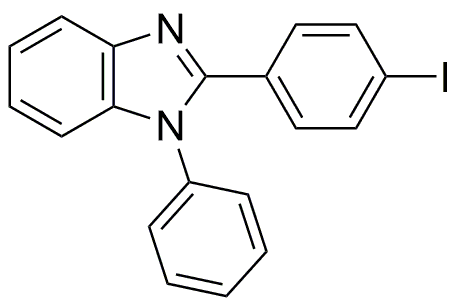2-(4-Iodophenyl)-1-phenylbenzimidazole is widely utilized in research focused on:
- Pharmaceutical Development: This compound serves as a key intermediate in the synthesis of various pharmaceuticals, particularly those targeting cancer and other serious diseases.
- Photodynamic Therapy: Its unique properties make it suitable for applications in photodynamic therapy, where it can be used to enhance the effectiveness of light-activated drugs in treating tumors.
- Material Science: The compound is explored in the development of advanced materials, including organic light-emitting diodes (OLEDs), due to its excellent light absorption characteristics.
- Biochemical Research: Researchers utilize this chemical in studies examining cellular processes, particularly in understanding the mechanisms of action of certain biological pathways.
- Analytical Chemistry: It is employed as a reagent in various analytical methods, aiding in the detection and quantification of other compounds in complex mixtures.
General Information
Properties
Safety and Regulations
Applications
2-(4-Iodophenyl)-1-phenylbenzimidazole is widely utilized in research focused on:
- Pharmaceutical Development: This compound serves as a key intermediate in the synthesis of various pharmaceuticals, particularly those targeting cancer and other serious diseases.
- Photodynamic Therapy: Its unique properties make it suitable for applications in photodynamic therapy, where it can be used to enhance the effectiveness of light-activated drugs in treating tumors.
- Material Science: The compound is explored in the development of advanced materials, including organic light-emitting diodes (OLEDs), due to its excellent light absorption characteristics.
- Biochemical Research: Researchers utilize this chemical in studies examining cellular processes, particularly in understanding the mechanisms of action of certain biological pathways.
- Analytical Chemistry: It is employed as a reagent in various analytical methods, aiding in the detection and quantification of other compounds in complex mixtures.
Documents
Safety Data Sheets (SDS)
The SDS provides comprehensive safety information on handling, storage, and disposal of the product.
Product Specification (PS)
The PS provides a comprehensive breakdown of the product’s properties, including chemical composition, physical state, purity, and storage requirements. It also details acceptable quality ranges and the product's intended applications.
Certificates of Analysis (COA)
Search for Certificates of Analysis (COA) by entering the products Lot Number. Lot and Batch Numbers can be found on a product’s label following the words ‘Lot’ or ‘Batch’.
*Catalog Number
*Lot Number
Certificates Of Origin (COO)
This COO confirms the country where the product was manufactured, and also details the materials and components used in it and whether it is derived from natural, synthetic, or other specific sources. This certificate may be required for customs, trade, and regulatory compliance.
*Catalog Number
*Lot Number
Safety Data Sheets (SDS)
The SDS provides comprehensive safety information on handling, storage, and disposal of the product.
DownloadProduct Specification (PS)
The PS provides a comprehensive breakdown of the product’s properties, including chemical composition, physical state, purity, and storage requirements. It also details acceptable quality ranges and the product's intended applications.
DownloadCertificates of Analysis (COA)
Search for Certificates of Analysis (COA) by entering the products Lot Number. Lot and Batch Numbers can be found on a product’s label following the words ‘Lot’ or ‘Batch’.
*Catalog Number
*Lot Number
Certificates Of Origin (COO)
This COO confirms the country where the product was manufactured, and also details the materials and components used in it and whether it is derived from natural, synthetic, or other specific sources. This certificate may be required for customs, trade, and regulatory compliance.


